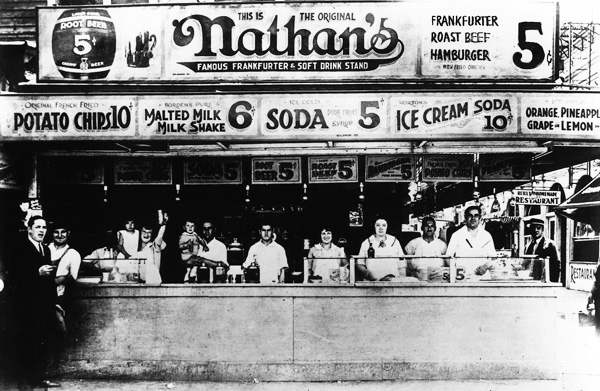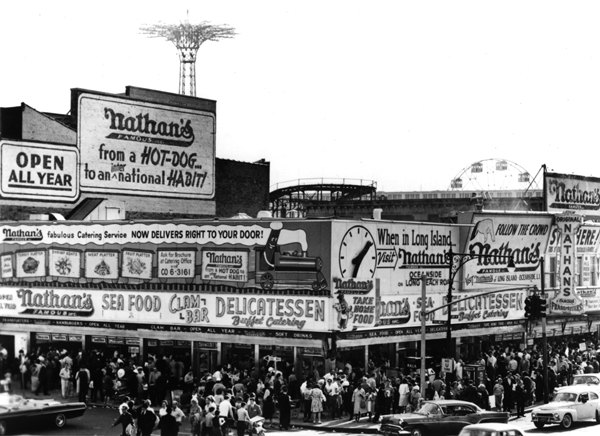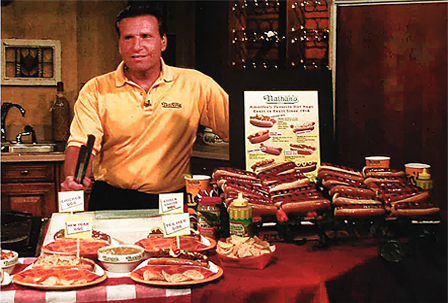
Nathan’s Famous Senior Director of Operations Talks About Nathan’s and His Brooklyn Roots
“I remember my grandmother on my father’s side making French fries just like Nathan’s French fries. I can remember that because when I ate Nathan’s French fries as a kid I would think, oh yea, this is just like Grandma’s French Fries.”
In today’s economy, where it is normal for people to go through several careers and many different jobs during their lifetime, Brooklyn native and Senior Director of Company Operations at Nathan’s Famous, Bruce Miller, told the Brooklyn Eagle that he’s only had two jobs in his life: Working concessions at Long Island’s Jones Beach and Nathan’s. Miller went from growing up as one of Nathan’s big fans to one of its senior executives. “I’ve worked at Nathan’s for 36 years, since I was 21, and that’s all I know.”
Miller climbed the corporate ladder up through one of Brooklyn’s most successfully marketed and recognizable icons. In 2016, Nathan’s popular hot dog and French fry restaurant at Coney Island will celebrate its 100th anniversary. Nathan’s Famous currently sells over 500 million hot dogs a year at over 50,000 food service and retail outlets worldwide. The annual 4th of July Nathan’s Famous International Hot Dog Eating Contest is presented on ESPN2 like a major sporting event.
And make no mistake about it, Nathan’s Famous is definitely famous. Movies stars like Jimmy Durante and Cary Grant and the gangster Al Capone were all regular customers in the early days. President Franklin Roosevelt served Nathan’s hot dogs to King George VI and Queen Elizabeth. Roosevelt even had Nathan’s hot dogs sent to Yalta when he was meeting with Winston Churchill and Joseph Stalin. Legendary Brooklynite Barbara Streisand had Nathan’s hot dogs sent to London for a private party. Ex-New York City Mayor Rudy Giuliani called Nathan’s the “Best hot dog in the world.”

BE: What was it about Nathan’s at Coney Island that caught your attention?
BM: “I remember my grandmother on my father’s side making French fries just like Nathan’s French fries,” Miller said. “I can remember that because when I ate Nathan’s French fries as a kid I would think, oh yeah, this is just like grandma’s French fries.”
BE: I’ve interviewed so many other Brooklynites who considered Nathan’s the holy grail of places to at while visiting Coney Island. Are you one of them?
BM: “Yes, I also remember Nathan’s as a place for the family outing. My father would say ‘who wants hot dogs’ , and that’s when I knew we were going to Nathan’s. He had a 1958 DeSoto, a real 1950’s car. He’d pull up and double park in front of Nathan’s. He’d get out of the car, bring back the hot dogs, then get out of the car again to go get the French fries. We’d start eating before he could get back with the fries. At that time you had to buy the hot dogs at one part of the stand and the French fries at another. My father kept running back and forth. In about 10 minutes he’d have all the food sitting in our laps. I remember those hot dogs were so full of flavor. They didn’t have sauerkraut back then, just mustard and ketchup. I remember that vividly.”
BE: You also lived close t0 Coney Island didn’t you?
BM: “When I lived on Bay 50th and Cropsey Avenue right off the Belt Parkway, I could walk to Coney Island,. I remember I could see the Verrazano Bridge being constructed from where we lived. My mother would give us $5 and we would walk down to Coney Island. In those days your parents never thought it was not safe to walk around Brooklyn. We had to walk about two miles and I remember making a left on Surf Avenue to get there. There was a movie theatre across the street from Nathan’s. So she gave us $5 and my brother and I would go see the movies at the Shore Theatre on Surf Avenue.”

BE: So what could two two kids do with $5 at Coney Island in the mid-60s.
BM: “I think I remember the movie costs 50 cents. All I knew was we had a lot of money. We’d watch the movie, get a popcorn and soda and after the movie we’d go across the street to Nathan’s and get hot dogs, French-fries and Cokes.”
BE: Were your parents or grand parents immigrants?
BM: “Yes they were. My grandfather on my father’s side was named Yukavetski. When he arrived at Ellis Island, they couldn’t understand his name or spell Yu-ka-vet-ski, so they changed it to Miller. My grandfather and his family would have been killed during the Russian pogroms in the early 1900s if they had stayed. The authorities took everything from them and kicked them out of Russia. My mother was born in Brooklyn and her grandparents also immigrated from Russian to Brooklyn, although they were simply looking for a better life. My parents and grandparents had no money. They didn’t consider themselves poor, but they had nothing.
BE: What happened after you moved to Long Island?
BM: “We moved to Long Island when I was 16 and I continued going to Nathan’s at Sunrise Mall in Massapequa. I watched the managers run the store and remember thinking at age 16 that I could do that. I thought that would be a good job for me. Don’t ask me how or why, but I remember thinking that. I had not idea I would eventually work at Nathan’s.
BE: Sounds like you subconsciously wanted to work and earn money. Did you go out get a job?
BM: “I went to college and got a job. When I was 18 I went to Nassau Community College for two years. I got a job with the Jones Beach Catering Corporation, which managed all the concessions at Jones Beach. They started me as a counter worker making $1.85 an hour. They taught me how to cook.
“They had a hot dog grill at the beach and those hot dogs were similar to Nathans, nevertheless, they still didn’t taste the same,” Miller said. “I knew how hot dogs were supposed to taste. The manager came to me one day and said, ‘Bruce, you’re doing a really good job, where did you learn to cook hot dogs?’ I remember telling him I learned from watching them cook hot dogs at Nathan’s. That’s when he said, ‘I want you to be the hot dog man from now on.’”
Miller said that while working at Jones Beach, he even imagined that he was working for Nathan’s.
“I think I was 19 when they made me manager of a concession,” Miller said. “Then they put me in charge of the restaurant and I managed 60 employees. I had no understanding of management, or how to deal with people, but somehow I was in charge. I didn’t make a lot of money, but money wasn’t the point. The point was, I was working at the beach, I was making money for college and I was learning a trade that is the concession and restaurant businesses.”
BE: When did you first start working for Nathan’s?
BM: In 1977, I was 21 and just out of college. I he landed an interview with Nathan’s. In spite of my lack of managerial experience, Nathan’s hired me. I left the interview thinking I would not get the job, but a week after the interview the vice president of personnel called me and said, “Your salary is $200 a week and you start on Monday. You’ll need black shoes and black plants, and we’ll give you a uniform.”
He did his training at the Nathan’s on Bay Parkway in Brooklyn and worked in the Nathan’s compact stores (a smaller version of their larger stores) that sold the main signature items like hot dogs and French fries with a limited menu.
“For years I worked six nights a week until they promoted me to general manager and then to district manager,” Miller said. “I remember working in the compact stores and receiving my first raise. I was given a $25 increase and thinking I had all the money in the world.”
Miller actually left Nathan’s for a brief period in 1987. He went to work for a Nathan’s franchisee for a couple of years but that didn’t work out. “It wasn’t the product, it was just a series of bad deals,” he said.
He wanted to return to Nathan’s, and was welcomed back. In fact, along with his return came a promotion to senior district manager.
BE: Why were they so quick to take you back?
MB: “I had built a good relationship with the President & Chief Operating Officer Wayne Norbitz, and I think they liked that I was loyal, I could be trusted, and I was hard-working. Any time someone would teach me something along the way I would just learn it and start doing it.”

BE: You sent a picture of you on set at QVC. Did you like selling Nathan’s products on television?
BM: I sold Nathan’s products on QVC for two years. It was interesting because on air, we had a limited amount of time, but everybody was calling in wanting to tell us all their Brooklyn stories. Everybody seemed to be from Brooklyn, whether they lived in California or Arizona, somebody always had a story about Brooklyn and Nathan’s.”
BE: What going on right now with Nathan’s?
BM: “Nathan’s is doing a marketing campaign with the John Morrell Food Group. It’s abouat expanding and promoting product development. I’m not specifically involved in that marketing strategy although I believe in it and stay aware of how it’s going. I’m always involved in Nathan’s business in terms of marketing and product development, but the core of my responsibilities is to run the company-owned restaurants. For example, I run the original Coney Island restaurant, the one I used to go to when I was a kid, which is my greatest joy.”
BE: Last question. What would you say are the primary values you took with you from your Brooklyn childhood?
BM: My Brooklyn upbringing and the values I learned, and with a big assist from Nathan’s, stick with him to this day. My mother taught me never to lie, and my father often echoed that; always tell the truth and work hard.”
All photographs Courtesy of Nathan’s Famous.